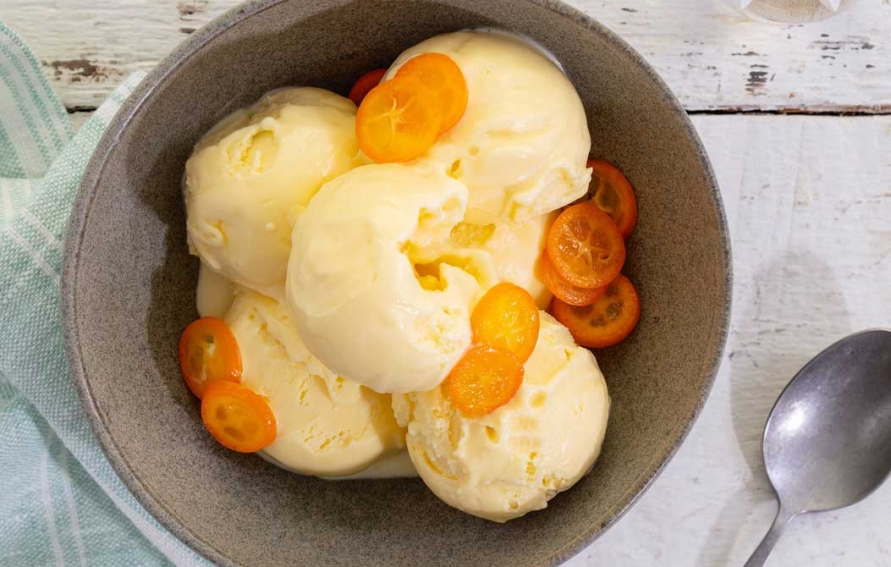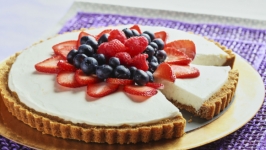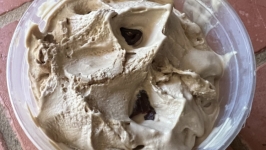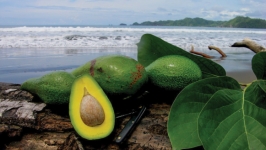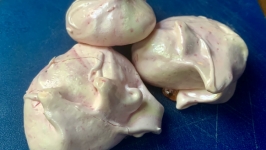Ingredients
- 1 1/3 cups milk (315 ml/322 grams)
- 1 1/3 cups heavy cream (315 ml/310 grams)
- 2 tablespoons (13 grams) nonfat dry milk
- 2/3 cup sugar (133 grams)
- 2 tablespoons (30 ml/42 grams) glucose or reduced corn syrup (see recipe below)
- 4-6 large egg yolks (1/4 cup plus 2 teaspoons/69 ml)
- 1/3 cup extra-virgin olive oil (1/3 cup/79 ml)
About this recipe
Makes about 1 quart/1 liter
I first tasted this exceptional ice cream two decades ago at the Monkey Bar in New York City. It was the silkiest ice cream I had ever experienced. I had no idea it contained olive oil until chef Andrew Chase gave me his recipe. It called for a large amount of glucose powder, which is not readily available to home cooks, but now that liquid glucose is more readily available, I finally decided to adapt the recipe. The flavor of the olive oil is very melodious and subtle and stays in the background but, of course, it depends on your choice of olive oil. I especially like Greek olive oils with a slightly grassy aroma and not too much peppery flavor. If desired, serve the ice cream with a garnish of sliced fresh kumquats.
Instructions
Have ready a fine-mesh strainer suspended over a medium bowl. Prepare an ice water bath.
In a small saucepan, with a silicone spatula, stir together the milk, 155 grams/⅔ cup/158 ml of the cream, and the dry milk until well blended. Stir in the sugar, glucose and salt until the sugar has dissolved. Bring the milk mixture to a slow boil, stirring constantly. Lower the heat and cook at a slow boil, stirring, for 2 to 3 minutes to evaporate some of the water in the mixture. Allow it to cool slightly.
In a medium saucepan, place the egg yolks. Whisk a little of the milk mixture into the yolks and then gradually whisk in the remainder. Heat the mixture on medium-low, stirring constantly with a silicone spatula until slightly thicker than heavy cream. When a finger is run across the back of the spatula, it will leave a well-defined track. An instant-read thermometer should read 170° to 180°F/77° to 82°C.
Immediately pour the mixture into the strainer, scraping up the thickened mixture that has settled on the bottom of the pan. Press it through the strainer and scrape any mixture clinging to the underside into the bowl. Stir in the remaining cream (155 grams/⅔ cup/158 ml).
Set the bowl in the ice water bath and allow it to cool until no longer warm to the touch, stirring occasionally. Stir in the olive oil. Cover and refrigerate for a minimum of 8 hours or until no warmer than 43°F/6°C. (Alternatively, continue cooling it in the ice water bath.) Set a covered storage container in the freezer.
Churn the olive oil custard in a pre-chilled ice cream maker. Transfer the ice cream to the chilled container.
Press a piece of plastic wrap on the surface of the ice cream, cover the container, and allow the ice cream to firm in the freezer for at least 4 hours before serving.
STORE Covered storage container: frozen, 3 days
Glucose and Corn Syrup
Glucose, an invert sugar (formed through hydrolysis, or breakdown of sucrose), is an indispensable ingredient for minimizing ice crystals and keeping ice cream “scoopable,” because it bonds more with water than does granulated sugar (sucrose), so less water is available to freeze into ice. Corn syrup can be substituted for glucose, but it is best to thicken it to the moisture level of glucose – easily done. If you just use it straight, it will not be as effective as glucose.
Years ago, when glucose was harder to find, I worked out the following substitution for liquid glucose for making rolled fondant in The Cake Bible. Glucose is now widely available in candy making and cake baking supply stories and online. But if you don’t have any on hand, it is handy to have this technique.
To replace glucose with corn syrup, in a glass measure with a spout in a microwave, or in a small, preferably nonstick pan on the cooktop over medium-low heat, bring 80 grams/1/4 cup/59 ml of light corn syrup to a full boil. Remove it from the heat source and stir in an equal weight or volume of corn syrup. This will result in the same consistency of glucose. Corn syrup weighs only 1 gram less per tablespoon than glucose, so it can be used in equal weight or measure but will not be quite as effective in preventing iciness.
I usually use 4.5% glucose in my recipes, or 5% if an ice cream freezes very hard; no more than 5% should be used.

